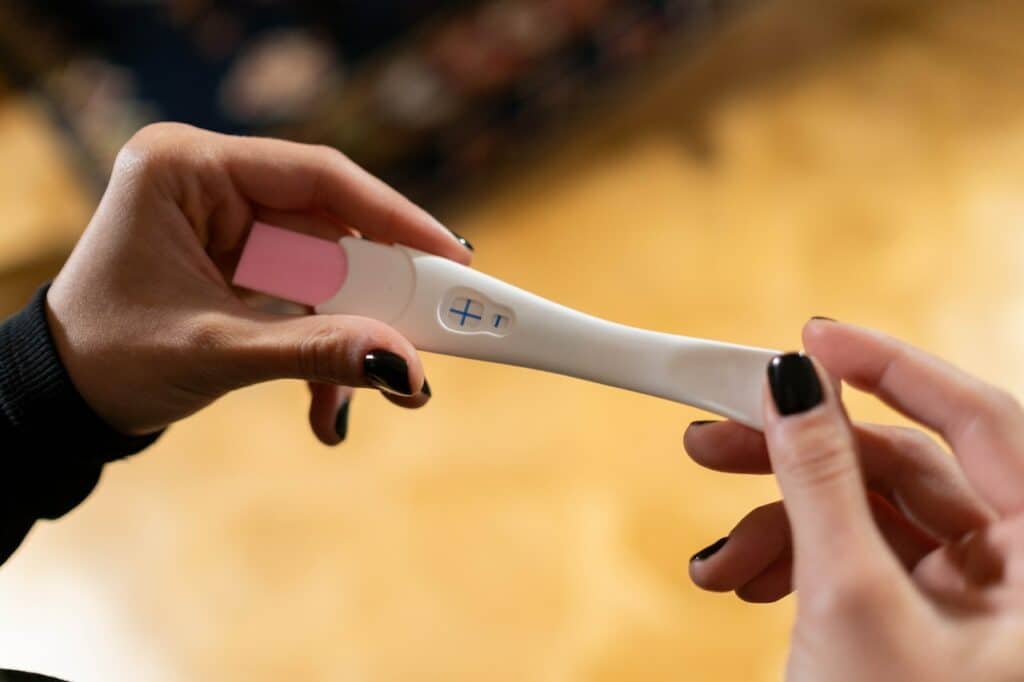Pregnancy tests are a popular and reliable way to determine if a woman is pregnant. However, false negative results can occur due to the hook effect. The hook effect is a phenomenon that can affect the accuracy of pregnancy tests, causing them to show a negative result even when a woman is pregnant. Lets discover how common is the hook effect in pregnancy test.
Understanding the hook effect is important for anyone who is trying to conceive or who is concerned about the accuracy of their pregnancy test. The hook effect occurs when the levels of the pregnancy hormone hCG are so high that they overwhelm the antibodies in the pregnancy test, causing a false negative result. This can be especially common in women who are carrying multiples or who have high levels of hCG due to other medical conditions.
Despite its potential for causing false negative results, the hook effect is relatively uncommon. Most women will not experience the hook effect when taking a pregnancy test. However, it is important to be aware of the possibility of the hook effect and to seek medical advice if you suspect that you may be pregnant despite a negative test result.
Key Takeaways
- The hook effect can cause false negative results in pregnancy tests.
- The hook effect is caused by high levels of hCG overwhelming the antibodies in the test.
- The hook effect is relatively uncommon, but it is important to be aware of its possibility.
Understanding the Hook Effect

The Hook Effect is a phenomenon that occurs in pregnancy tests when the concentration of the hormone human chorionic gonadotropin (hCG) in a woman’s urine is too high. This can result in a false negative result, which means that the test will show up as negative even though the woman is pregnant.
The Hook Effect occurs because of the way pregnancy tests work. These tests detect the presence of hCG, which is a molecule produced by the placenta after a fertilized egg has implanted in the uterus. The tests work by using antibodies that are specific to hCG. These antibodies bind to the hCG molecules in the urine, causing a chemical reaction that produces a visible line on the test.
However, if the concentration of hCG in the urine is too high, the antibodies can become saturated. This means that they are unable to bind to all of the hCG molecules in the urine, and the chemical reaction that produces the visible line on the test does not occur. This can result in a false negative result.
The Hook Effect can be a frustrating experience for women who are trying to conceive. However, it is important to remember that this phenomenon is relatively rare. Most women will not experience the Hook Effect when using a pregnancy test.
There are a few things that women can do to reduce the risk of experiencing the Hook Effect. One is to wait until a few days after a missed period before taking a pregnancy test. This will give the concentration of hCG in the urine time to increase to a level that is detectable by the test.
Another option is to dilute the urine with water before taking the test. This can help to reduce the concentration of hCG in the urine, making it easier for the antibodies to bind to all of the hCG molecules present.
In conclusion, the Hook Effect is a rare phenomenon that can occur in pregnancy tests when the concentration of hCG in a woman’s urine is too high. However, there are steps that women can take to reduce the risk of experiencing this phenomenon.
Hook Effect in Pregnancy Tests

The hook effect is a phenomenon that can occur in pregnancy tests, both home pregnancy tests and clinical tests. It happens when the level of human chorionic gonadotropin (hCG), the hormone that indicates pregnancy, is so high that it overwhelms the test’s ability to detect it. As a result, the test may show a false negative result, even though the woman is pregnant.
The hook effect is more likely to occur in women who are carrying multiples, as their hCG levels tend to be higher. It is also more common in later stages of pregnancy, when hCG levels are at their peak.
Home pregnancy tests are more likely to be affected by the hook effect than clinical tests, as they are less sensitive and have a narrower range of detection. However, many home pregnancy tests now have a sensitivity level of 25 mIU/mL, which makes them less susceptible to the hook effect.
Urine pregnancy tests are more likely to be affected than blood tests, as urine tests are less sensitive and have a lower range of detection. Blood tests are more accurate and can detect hCG at lower levels, making them less susceptible to the hook effect.
If a woman suspects that the hook effect may be affecting her pregnancy test results, she should speak to her healthcare provider. They may recommend a blood test, which is more accurate and less likely to be affected by the hook effect.
In conclusion, while the hook effect is a rare phenomenon, it can occur in pregnancy tests, particularly in women carrying multiples or in later stages of pregnancy. It is more likely to affect home pregnancy tests and urine tests than clinical tests and blood tests. If a woman suspects that the hook effect may be affecting her test results, she should speak to her healthcare provider for further testing.
Causes of False Negative Results
False-negative results can occur in pregnancy tests due to various reasons. A false-negative result occurs when a test indicates that a woman is not pregnant when, in fact, she is. Below are some of the causes of false-negative results in pregnancy tests:

1. Dilution of Urine
If a woman drinks a lot of water or other fluids before taking a pregnancy test, the urine may become diluted, leading to a false-negative result. This is because the concentration of hCG (human chorionic gonadotropin) in the urine is lower, making it difficult for the test to detect the hormone.
2. High hCG Levels
In some cases, a woman may have high hCG levels, which can also cause a false-negative result. This is because the pregnancy test may not be sensitive enough to detect the high levels of hCG in the urine.
3. Substances and Medications
Certain medications and substances can interfere with the accuracy of a pregnancy test, leading to false-negative results. For example, diuretics, antihistamines, and tranquilizers can dilute urine, while fertility drugs can increase hCG levels, leading to false-negative results.
4. Water in the System
If a woman has water in her system due to a medical condition or medication, this can also cause a false-negative result. This is because the water can dilute the urine, making it difficult for the pregnancy test to detect hCG.
In conclusion, false-negative results can occur in pregnancy tests due to various reasons, including dilution of urine, high hCG levels, substances, medications, and water in the system. It is important for women to follow the instructions on the pregnancy test carefully and to consult with a healthcare provider if they have any concerns about the accuracy of the test result.
Detecting the Hook Effect

The hook effect is a phenomenon that can occur in pregnancy tests, where extremely high levels of hCG (human chorionic gonadotropin) can cause a false negative result. This can be a frustrating experience for women who are trying to confirm their pregnancy, and it is important for doctors and other healthcare professionals to be aware of the hook effect and how to detect it.
One way to detect the hook effect is by performing a dilution test. This involves diluting the urine sample with water or saline solution and then retesting it. If the original test was a false negative due to the hook effect, the diluted sample should show a positive result.
Another way to detect the hook effect is by using a different type of pregnancy test, such as a blood test. Blood tests are more sensitive than urine tests and can detect lower levels of hCG. If a woman has a suspected hook effect, her doctor may recommend a blood test to confirm the pregnancy.
Ultrasound can also be used to detect the hook effect. If a woman has a negative pregnancy test but is experiencing symptoms of pregnancy, an ultrasound can be performed to check for the presence of a gestational sac or fetal heartbeat.
It is important for women to follow the instructions on their pregnancy test carefully and to consult with their doctor if they have any concerns about the accuracy of their test results. Healthcare professionals should also be aware of the hook effect and how to detect it in order to provide the best possible care to their patients.
How Common is the Hook Effect

The hook effect, also known as the prozone effect, is a rare phenomenon that can occur in pregnancy tests. It happens when the concentration of the hormone human chorionic gonadotropin (hCG) in a woman’s urine is very high, which can cause false negative results.
In typical pregnancy cases, the hook effect is not a concern for most women. Pregnancy tests are highly accurate, and false negatives are rare. However, in some rare cases, the hook effect can occur and cause confusion.
It is important to note that the hook effect is not a widespread issue and is not a cause for concern for most women. False negatives caused by the hook effect are rare and only occur in a small percentage of cases.
To prevent false negatives caused by the hook effect, some pregnancy tests have a built-in dilution mechanism. This mechanism dilutes the urine sample, reducing the concentration of hCG and preventing the hook effect from occurring.
In summary, while the hook effect can occur in pregnancy tests, it is a rare phenomenon that is not a concern for most women. False negatives caused by the hook effect are rare, and pregnancy tests are highly accurate.
Hook Effect and Multiple Pregnancies

The hook effect is a phenomenon that can affect the accuracy of pregnancy tests, especially in cases of multiple pregnancies. When a woman is pregnant with more than one fetus, the levels of the pregnancy hormone human chorionic gonadotropin (hCG) in her urine can become so high that they saturate the antibodies in the pregnancy test. As a result, the test may show a negative result even though the woman is actually pregnant.
This can be a particularly frustrating experience for women who are trying to conceive and are excited about the possibility of having twins, triplets, or more. However, it is important to remember that the hook effect is relatively rare and affects only a small percentage of women.
In cases of multiple pregnancies, it is also important to consider the timing of implantation. If the embryos implant at different times, the levels of hCG may not rise at the same rate. This can result in one fetus having a much higher level of hCG than the others, which can also affect the accuracy of pregnancy tests.
It is also worth noting that the hook effect is more likely to occur in later stages of pregnancy, when hCG levels are at their highest. In early pregnancy, the levels of hCG are typically lower and the hook effect is less likely to occur.
Overall, while the hook effect can be a concern for women who are pregnant with multiples, it is important to remember that it is a relatively rare phenomenon. Women who are concerned about the accuracy of their pregnancy tests should speak with their healthcare provider, who can provide guidance and support throughout their pregnancy journey.
Other Conditions Related to Hook Effect
The hook effect is a rare phenomenon that can occur in pregnancy tests. However, there are other conditions that can also affect the results of a pregnancy test. In this section, we will discuss some of these conditions and how they can affect the accuracy of a pregnancy test.

1. Molar Pregnancy
A molar pregnancy is a rare condition that occurs when the fertilized egg develops into a tumor instead of a fetus. Molar pregnancies can produce high levels of hCG, which can cause a false positive on a pregnancy test. However, in most cases, molar pregnancies are diagnosed before a pregnancy test is taken.
2. Hydatidiform Mole
A hydatidiform mole is a type of molar pregnancy that occurs when the fertilized egg develops into a mass of cysts instead of a fetus. Like molar pregnancies, hydatidiform moles can produce high levels of hCG and cause a false positive on a pregnancy test.
3. Cancer
Certain types of cancer, such as ovarian cancer and testicular cancer, can produce hCG and cause a false positive on a pregnancy test. However, this is rare and usually only occurs in advanced cases of cancer.
4. Thyroid
Thyroid problems can also affect the results of a pregnancy test. High levels of thyroid-stimulating hormone (TSH) can cause a false positive, while low levels of TSH can cause a false negative.
5. Viable Pregnancy
Finally, it is important to note that a viable pregnancy can also affect the results of a pregnancy test. In some cases, a woman may take a pregnancy test too early and receive a false negative result. It is recommended to wait until a missed period before taking a pregnancy test to ensure accuracy.
Overall, while the hook effect is a rare occurrence in pregnancy tests, there are other conditions that can also affect the accuracy of the results. It is important to consult with a healthcare provider if there are any concerns about the results of a pregnancy test.
Symptoms Despite Negative Test
In some cases, women may experience pregnancy symptoms despite receiving a negative pregnancy test result. This can be a confusing and frustrating experience, but it is important to understand that there are several reasons why this may occur.

One common reason for this discrepancy is the hook effect. This occurs when a woman’s hCG levels are so high that they exceed the detection limit of the pregnancy test. As a result, the test may show a negative result even though the woman is indeed pregnant.
Other possible explanations for pregnancy symptoms despite a negative test include:
- Stress and anxiety: High levels of stress and anxiety can cause physical symptoms that mimic those of pregnancy, such as nausea and fatigue.
- Hormonal imbalances: Changes in hormone levels can cause a range of symptoms, including bloating and breast tenderness.
- Medications: Certain medications can cause side effects that resemble pregnancy symptoms.
- Medical conditions: Conditions such as polycystic ovary syndrome (PCOS) can cause irregular periods and other symptoms that may be mistaken for pregnancy.
It is important for women who experience pregnancy symptoms despite a negative test to consult with their healthcare provider. They can help determine the underlying cause of the symptoms and provide appropriate treatment or guidance.
In some cases, a follow-up pregnancy test may be recommended after a few days or weeks. If the symptoms persist or worsen, additional testing or evaluation may be necessary to rule out other medical conditions.
Conclusion
In conclusion, the hook effect is a rare occurrence in pregnancy tests but it can happen. It is more likely to occur in women who are carrying multiples or who have high levels of hCG. However, this should not cause undue concern for women taking pregnancy tests.
It is important to note that pregnancy tests are highly accurate when used correctly. Women who receive a positive result can be confident in the accuracy of the test. However, it is recommended that women who receive a positive result follow up with their healthcare provider to confirm the pregnancy and begin prenatal care.
For women who receive a negative result but suspect they may be pregnant, it is recommended to wait a few days and take another test. It is also important to follow the instructions on the pregnancy test carefully to ensure accurate results.
Overall, the hook effect is not a common occurrence in pregnancy tests and should not cause undue concern for women. By following the recommended procedures and seeking prenatal care, women can ensure a healthy pregnancy and baby.
Frequently Asked Questions
What is the Hook effect in pregnancy tests?
The Hook effect is a phenomenon that can occur in pregnancy tests when the levels of the hormone human chorionic gonadotropin (hCG) in a woman’s urine or blood are so high that they saturate the antibodies in the test. This can result in a false negative result, meaning the test shows up negative even though the woman is actually pregnant.
Can the Hook effect cause a false negative pregnancy test?
Yes, the Hook effect can cause a false negative pregnancy test. This occurs when the levels of hCG in a woman’s urine or blood are so high that they saturate the antibodies in the test, preventing them from binding to the hCG and producing a positive result.
What are the symptoms of the Hook effect in pregnancy tests?
The Hook effect itself does not cause any symptoms. However, if a woman is experiencing pregnancy symptoms and receives a negative result on a pregnancy test, it could be a sign that the Hook effect is occurring.
Is the Hook effect more common in blood or urine pregnancy tests?
The Hook effect can occur in both blood and urine pregnancy tests. However, it is more commonly seen in urine tests.
Are there any stories of the Hook effect causing confusion in pregnancy tests?
Yes, there have been cases where the Hook effect has caused confusion in pregnancy tests. Women who were actually pregnant received negative results on their tests and did not realize they were pregnant until they sought medical attention.
How can you avoid the Hook effect in pregnancy tests?
To avoid the Hook effect, it is recommended that women wait until they have missed a period before taking a pregnancy test. This will ensure that the levels of hCG in their urine or blood are not so high that they saturate the antibodies in the test and cause a false negative result. Additionally, women can dilute their urine with water or take a blood test to confirm a pregnancy if they suspect the Hook effect may be occurring.

Iesha is a loving mother of 2 beautiful children. She’s an active parent who enjoys indoor and outdoor adventures with her family. Her mission is to share practical and realistic parenting advice to help the parenting community becoming stronger.
